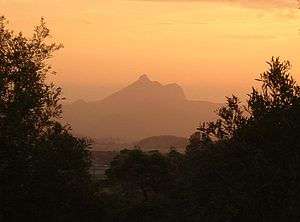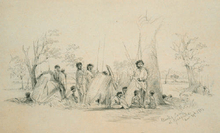Bundjalung people
The Bundjalung people (also known as Bunjalung, Badjalang and Bandjalang) are Aboriginal Australians who are the original custodians of the northern coastal area of New South Wales (Australia), located approximately 550 kilometres (340 mi) northeast of Sydney, an area that includes the Bundjalung National Park.
| Bundjalung people | |
|---|---|
| Aka: Badjalang (Tindale)(Horton) Bandjalang (SIL) | |
 South Eastern Queensland bioregion | |
| Hierarchy | |
| Language family: | Pama–Nyungan |
| Language branch: | Bandjalangic |
| Language group: | Bundjalung |
| Group dialects: | |
| Area (approx. 6,000 sq. km) | |
| Location: |
|
| Coordinates: | 29°15′S 152°55′E |
| Mountains: |
|
| Rivers[4] | Lower reaches of
|
| Other geological: | Cape Byron |
| Urban areas:[4] |
|
Bundjalung people all share descent from ancestors who once spoke as their first, preferred language one or more of the dialects of the Lower-Richmond branch of the Yugambeh-Bundjalung language family.
The Arakwal of Byron Bay count themselves as one of the Bundjalung peoples.[1]
Language
Bundjalung is a Pama-Nyungan language. It has two unusual features: certain syllables are strongly stressed while others are "slurred", and it classifies gender into four classes: (a) masculine (b) feminine (c) arboreal and (d) neuter.[6]
Country

According to Norman Tindale, Bundjalung tribal lands encompassed roughly 2,300 square miles (6,000 km2), from the northern side of the Clarence River to the Richmond River, including Ballina with their inland extension running to Tabulam and Baryugil. The coastal Widje horde ventured no further than Rappville.[4]
Initiation ceremony
According to R. H. Mathews, the Bundjalung rite of transition into manhood began with a cleared space called a walloonggurra some distance from the main camp. On the evening the novices are taken from their mothers around dusk, the men sing their way to this bora ground where a small bullroarer (dhalguñgwn) is whirled.[7]
Musical instruments
The Bundjalung used a variety of instruments including blowing on a eucalyptus leaf, creating a bird-like sound. Clapsticks were used to establish a drumbeat rhythm on ceremonial dancing occasions. Emu callers (short didgeridoos about 30 cm long) were traditionally used by the Bundjalung when hunting (Eastern Australia Coastal Emus). When striking the emu-caller at one end with the open palm it sounds like an emu. This decoy attracts the bird out of the bush making it an easy prey.
People
Internationally renowned artist Digby Moran (c.1948–13 January 2020) was a Bundjalung man. His work was frequently exhibited in Germany, and his art is held in regional galleries in Tweed, Lismore and Grafton regional galleries. He was born in Ballina and raised on Cabbage Tree Island, and coastal themes predominated in his artwork. He developed a diamond shape motif in his work, inspired by Bundjalung hunting clubs. He won international awards, and the exhibition of his work in Grafton was the most-visited exhibition ever at the gallery.[8]
Author Melissa Lucashenko is a Bundjalung woman, who won a Walkley Award for non-fiction in 2013 and Australia's most prestigious book award, the Miles Franklin Award, in 2019, the latter for her novel Too Much Lip.
Alternative names

- Badjelang. (paidjal/badjal means "man")
- Bandjalang, Bandjalong
- Budulung
- Buggul
- Bundela, Bundel
- Bunjellung
- Paikalyung, Paikalyug
- Watchee
- Widje. (clan or clans at Evans Head)
- Woomargou
Source: Tindale 1974, p. 191
See also
Notes
Citations
- Bunjalung of Byron Bay 2001.
- Sharpe 1994.
- Bandjalang at Ethnologue (20th ed., 2017)
- Tindale 1974, p. 191.
- Hoff 2006.
- Sharpe 1993, p. 76.
- Mathews 1900, pp. 67–73,67.
- Farrow-Smith 2020.
Sources
- "ATNS - Agreements, Treaties and Negotiated Settlements project". Agreements, Treaties and Negotiated Settlements (ATNS) project. Retrieved 14 May 2015.
- Bundock, M. (1889). "Note on the aborigines of Casino, N.S.W." Archiv für Ethnologie. 2: 52–53.CS1 maint: ref=harv (link)
- "Bunjalung of Byron Bay (Arakwal) Indigenous Land Use Agreement". Agreements, Treaties and Negotiated Settlements (ATNS) project. 28 August 2001.
- Farrow-Smith, Eloise (14 January 2020). "Digby Moran, internationally acclaimed First Nations artist, dies". ABC News. Retrieved 15 January 2020.CS1 maint: ref=harv (link)
- "Githabul People's native title determination: North-eastern New South Wales" (PDF). National Native Title Tribunal. 29 November 2007. Archived from the original (pdf) on 1 June 2011.
- Hoff, Jennifer (2006). Bunjalung Jugun [Bunjalung Country]. Richmond River Historical Society. ISBN 1-875474-24-2.CS1 maint: ref=harv (link) citing Yamba Yesterday, Howland and Lee, Yamba Centenary Committee.
- Langford Ginibi, Ruby (15 November 1995). "Ruby Langford Ginibi: Full interview transcript" (Interview). Interviewed by Robin Hughes. Australian Biography project. pp. 1–5.CS1 maint: ref=harv (link)
- Mathews, R. H. (1897a). "Totemic divisions of the Australian tribes". Proceedings of Royal Society of New South Wales. 31: 154–176.CS1 maint: ref=harv (link)
- Mathews, R. H. (1897b). "Wandarral of the Richmond and Clarence River tribes". Proceedings of the Royal Society of Victoria. 10: 29–42.CS1 maint: ref=harv (link)
- Mathews, R. H. (1898). "Initiation ceremonies of Australian tribes. Appendix Nguttan initiation ceremony". Proceedings of the American Philosophical Society. 37: 54–73.CS1 maint: ref=harv (link)
- Mathews, R. H. (1900). "Walloonggurra ceremony" (PDF). Queensland Geographic Journal. 15: 67–74.CS1 maint: ref=harv (link)
- Sharpe, Margaret C. (1985). "Bundjalung Settlement and Migration" (PDF). Aboriginal History. 9 (1): 101–124.CS1 maint: ref=harv (link)
- Sharpe, Margaret C. (1993). "Bunjalung: Teaching a Disappearing Language". In Walsh, Michael; Yallop, Colin (eds.). Language and Culture in Aboriginal Australia. Aboriginal Studies Press. ISBN 978-0-855-75241-5.CS1 maint: ref=harv (link)
- Sharpe, Margaret C. (1994). An all-dialect dictionary of Banjalang, an Australian language no longer in general use. Linguistic Society of the Philippines Special Monograph Issue. pp. 35–48.CS1 maint: ref=harv (link)
- Steele, John Gladstone (1984). Aboriginal Pathways: in Southeast Queensland and the Richmond River. University of Queensland Press. ISBN 978-0-702-25742-1.CS1 maint: ref=harv (link)
- Threlkeld, Lancelot; Fraser, John (1892). An Australian language as spoken by the Awabakal (PDF). Sydney: Government printer.CS1 maint: ref=harv (link)
- Tindale, Norman Barnett (1974). "Badjalang (QLD)". Aboriginal Tribes of Australia: Their Terrain, Environmental Controls, Distribution, Limits, and Proper Names. Australian National University Press.CS1 maint: ref=harv (link)
- "Troy Cassar-Daley". Talking Heads. Australian Broadcasting Corporation. 4 May 2009. Archived from the original on 18 October 2010. Retrieved 12 July 2011.
External links
- Bundjalung of Byron Bay Aboriginal Corporation, representing the Bundjalung and Arakwal people, land and waters
- Bibliography of Bundjalung language and people resources, at the Australian Institute of Aboriginal and Torres Strait Islander Studies
- "Australia's Sacred Sites Part 5 - Byron Bay" ABC Radio's Spirit of Things (October 2002; Accessed 21 May 2008
- A Walk in the Park Series: "New South Wales - Arakwal National Park" ABC Radio (December 2004) Accessed 21 May 2008
- "Badjalang" AusAnthrop Australian Aboriginal tribal database. Accessed 20 May 2008
- Bunjalung of Byron Bay (Arakwal) Indigenous Land Use Agreement (ILUA) Accessed 21 May 2008
- New South Wales Department of Environment and Climate Change Aboriginal cultural heritage webpage Living on the frontier Accessed 21 May 2008